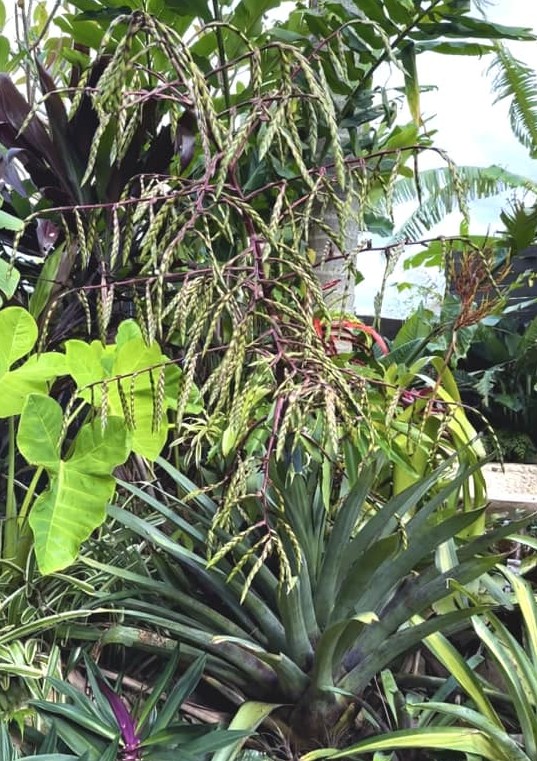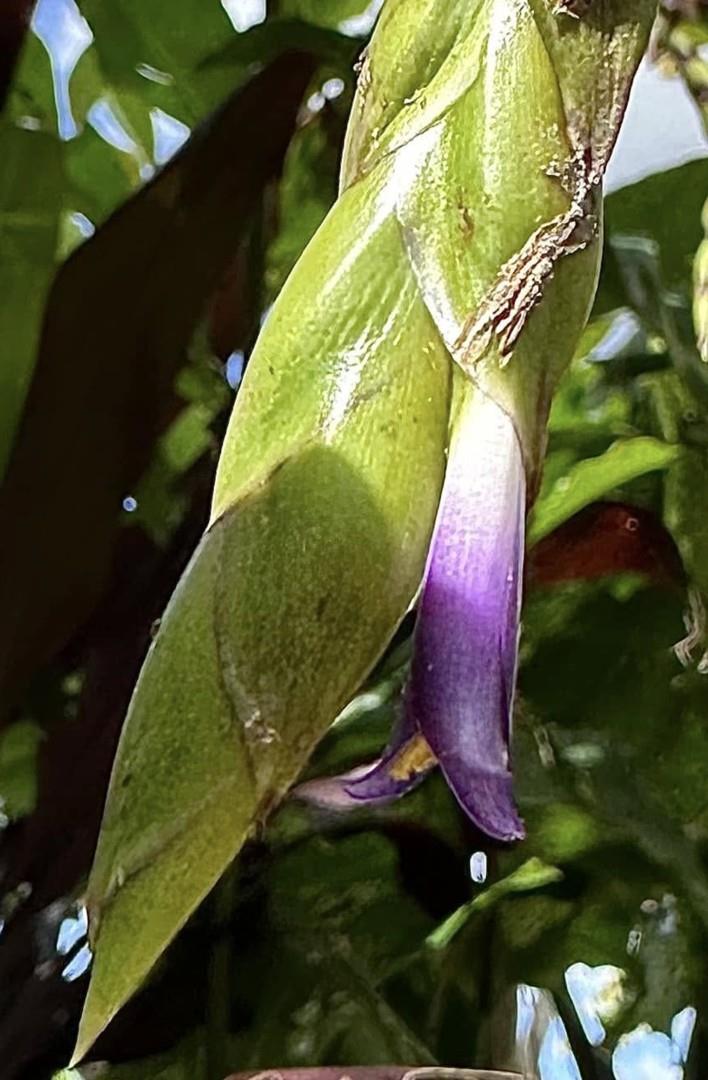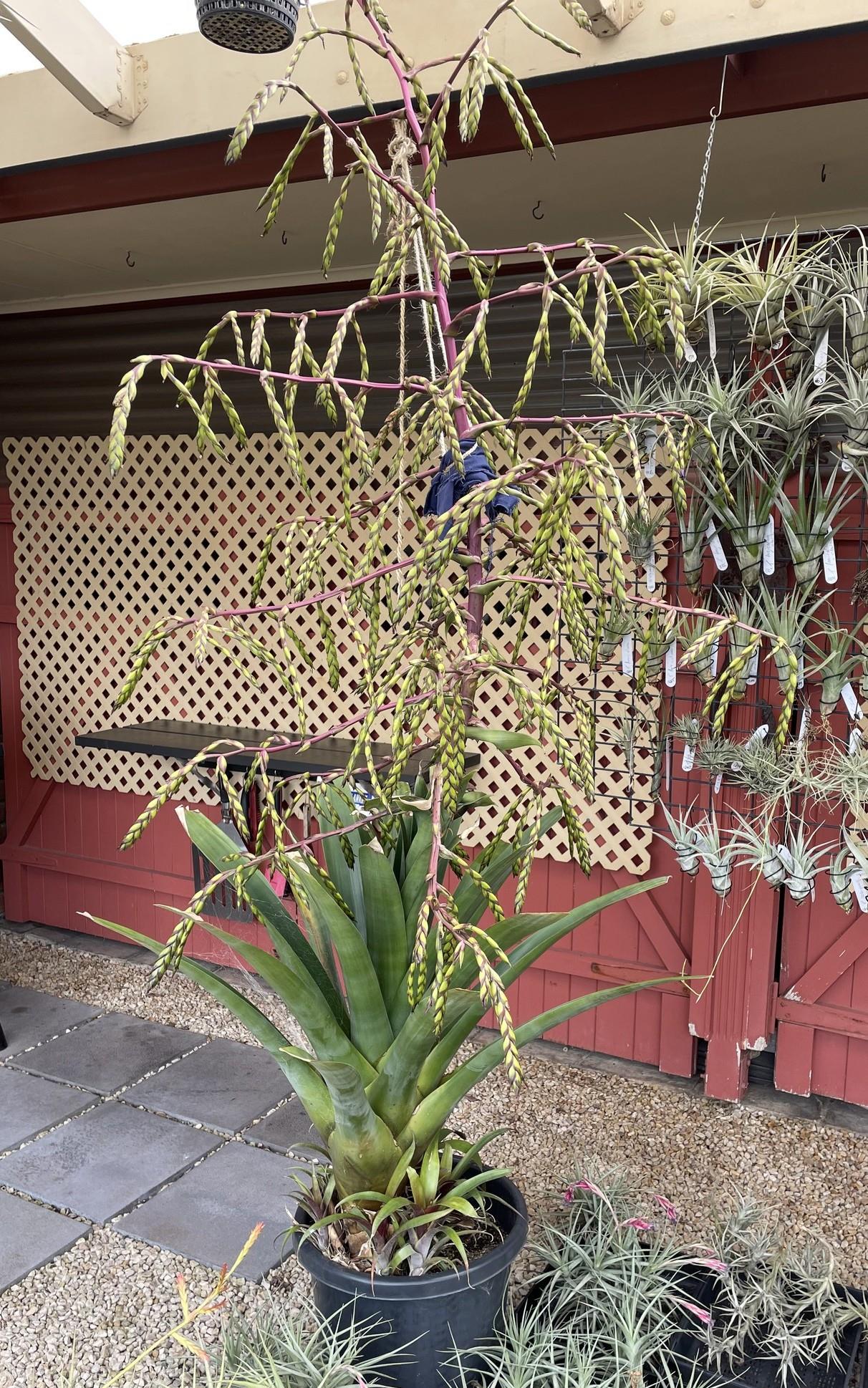Tillandsia zizkae
Click thumbnails for full size, scaled to a new window.
Tillandsia zizkae W. Till & Barfuss



| Brian White 10/24, Gold Coast, after 12 years growth |
Ray Clark 10/25 |
Ray Clark ... "This is T. zizkae in what I believe are the final throws of flowering. I posted a pic of a much younger (fresher) spike about a year ago on Till Addicts and Geoff Beech commented about not cutting the flower spike off too early.
The spike is not at its best anymore and the actual flowers, (deep purple) appear at random when the temps get above low 20s.
Plenty of pups at the base and I am now very tempted to do a Henry VIII"
Tillandsia zizkae W. Till & Barfuss, Bromelie 2022(2/3): 114-120, fig.1–11, 2023.
Type: BOLIVIA. Dpto. Santa Cruz: Samaipata, alt. c. 1,200 m a.s.l., leg. Jul. 1996, L.C. Marigo s.n., flowering in the Botanical Garden of the University of Vienna (WU-HBV) on 13 Aug. 2008 sub B350/96 {= 0024790} (holo LPB).
PLANT solitary, up to ca 1.2 m tall and 1.7 m broad, flowering ca 2.7 m to nearly 3 m tall and up to 1.9 m in diameter (at angled inflorescence), short caulescent, forming large water impounding open rosettes, vegetatively propagating by several long stolons formed before flowering at the short, leaf-less part of the stem.
LEAVES spirally arranged, numerous (ca 40), about equaling the peduncle, the oldest sometimes significantly longer, spreading, stiffly leathery;
sheath 20–30 × 15–20 cm, elliptic, ample, abaxially light brown and contrasting with the blade in color, adaxially dark brown, with a castaneous basal transversal zone, densely and minutely lepidote on both surfaces;
blade 45–75 × 9–12 (above the sheath) cm, sublingulate, glaucous-green, adaxially glabrous, abaxially minutely lepidote between the nerves proximally, apex attenuate and apiculate.
INFLORESCENCE (incl; peduncle) 200–300 cm long, 100–120 cm wide, erect to suberect, often inclined at an angle of ca 45 degrees to the shoot axis, terminal section often horizontal or more rarely pendant, laxly paniculate, pyramidal in outline, glabrous, axes carmine-red, twice branched with ca 20–25 spirally arranged branches and nodding spike;
peduncle (sterile part of the inflorescence) 50–70 cm long, 3.5 cm wide, erect, carmine-reddish, glabrous, covered by the peduncle bracts, about equaling the rosette;
peduncle bracts foliaceous, glaucous-green, exceeding the internodes, concealing the peduncle, 20–22 cm long, ca 5 cm wide, triangular, glabrous, imbricate, apex attenuate and apiculate;
fertile part of the inflorescence 150–230 cm long, 100–120 cm wide, erect, laxly paniculate, pyramidal in outline;
rachis (main axis) ca 135–220 cm long, 2(basally)–0.5(apically) cm in diameter, exposed and carmine-red;
primary bracts (branch bracts) (13–)(lowermost)5(middle)– 3(upper) cm long, (5–)2.5–1 cm wide, ovate, the lower ones with an attenuate apex, (equalling to) shorter than the stipes of the branches, the upper ones acuminate, spreading, glabrous, the lower ones coloured like the pecuncle bracts, the upper ones carmine-red;
primary branches the lower ones up to ca 60 cm long, the upper gradually getting shorter towards the top;
stipe (primary branches) (= distance to the first spike) with 1–2(–3) sterile slenderly ovate, carinate bracts;
rachis* (spike axis) nearly straight, angled, glabrous, pale green;
secondary bracts (spike bracts) 2–3 cm long, ovate, acuminate, carinate, glabrous, carmine-red, slightly longer than the stipes;
spikes (secondary branches) (9–)12–13(–17) cm long, 1.8–2.0 cm wide, dense, subdense when dry and exposing the rachilla, distichous, linear in outline, 10–14 flowered, with one sterile flower at the apex;
stipe* (spikes) 1–4 cm long, carmine-red, glabrous, with one carinate prophyll;
floral bracts 2.4–2.7 cm long, 0.6–0.7 cm wide, slenderly elliptic to obovate, smooth, apex shortly beaked, carinate and faintly nerved near the apex, green, dull violet at the apex and along the margins, glabrous abaxially, adaxially minutely lepidote, erect, contiguous to slightly imbricate, the rachis hardly visible, equalling the sepals to slightly exceeding them.
FLOWERS short pedicellate, ca 35 mm long;
receptacle (incl; pedicel) about one third of the ovary length;
sepals 21–25 mm long, 8–9 mm wide, green, only the extreme apex dull violet, elliptic, apex obtuse to rounded, equally free to adaxially connate for 1 mm, the adaxial ones obtusely carinate when fresh, distinctly when dry, coriaceous, with hyaline margins, brown (especially in fruit) in the centre, adaxially laxly and minutely brown appressed lepidote, abaxially glabrous and smooth;
petals lingulate, the tips spreading to recurved, 36 mm long, thin, narrowly rounded at the apex, dark violet, whitish in the lower half.
STAMENS ca 33 mm long, included, equal in length;
filament ca 28 mm long, white, straight, flat, fixed in the lower quarter of the anther length;
anther ca 5 mm long, brownish, linear, surrounding the stigma; pollen yellow.
PISTIL ca 31 mm long, slightly exceeded by the stamens;
ovary one third inferior, the superior part slenderly ovoidal, light green, 7 mm long, 2.5 mm wide, contracted into the style;
style ca 21 mm long, whitish, longer than the ovary;
stigma ca 3 mm, somewhat irregularly conduplicate-spiral, densely papillose;
ovules ca 0.7 mm long, slenderly ovoidal, the flat chalazal appendage as long as the ovule proper;
placentation in the lower half.
FRUITS 20–22 mm long, ellipsoidal, short-beaked, brown, about as long as the sepals;
seeds ca 8 mm long, slenderly fusiform, dark brown, with a short whitish undivided chalazal appendage and a whitish pseudopappus about as long as the seed.
Distribution: BOLIVIA: Santa Cruz
Habitat: terrestrial rooted in the soil in rocky terrain, 900-1400 m. Elev.
Etymology: This new species honours Prof. Dr. Georg Zizka (*1955) from Frankfurt am Main, Senckenberg Institute, Germany, for his longterm study of Bromeliaceae, especially Bromelioideae
Phenology: Tillandsia zizkae was found flowering in December and February and fruiting in August. The flowering period is likely to extend over a longer period, i.e., from December through April.
Edited from: Till & Barfuss 2023. (protologue) Tillandsia zizkae – A Giant New Endemic Species from Western Santa Cruz, Bolivia.
Updated 13/10/25


